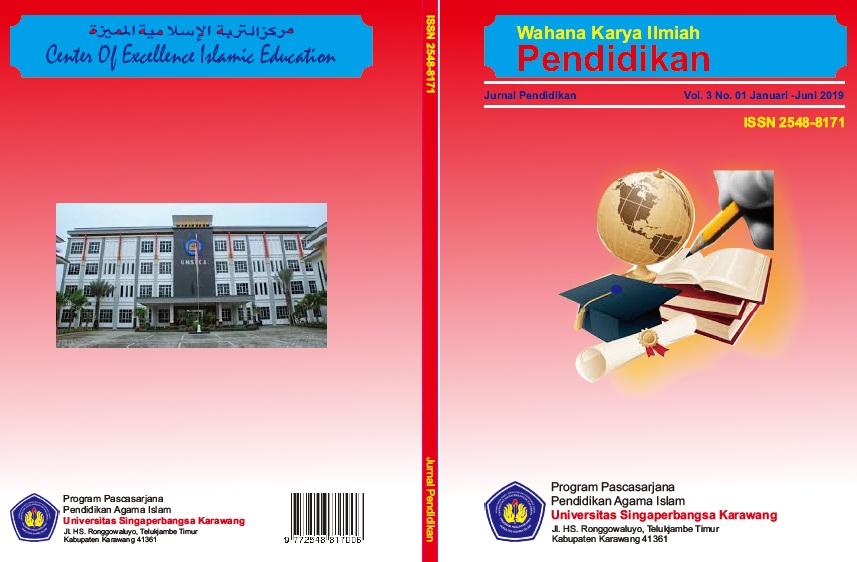SECONDARY SCHOOL STUDENTS’ ATTITUDE TOWARDS PHYSICS BASED ON GENDER AND GRADE LEVEL DIFFERENCES
Abstract
The main purpose of the present study is to investigate the differences on students’ attitudes toward Physics based on gender and grade level among Senior Secondary Education students. A group of approximately 864 male and female in eleventh- and twelfth-grade students, equally proportioned by gender were assigned to take part in this study. A standardized instrument namely The Test of Science Related Attitudes (TOSRA) questionnaire has been employed to collect data. A two-way Analyses of Variance (ANOVA) was used to quantitatively analyze the collected data. The study found that in general, male students do show more positive attitudes toward Physics than their female counterparts. Regarding grade level, twelfth grader show more positive attitudes toward Physics than eleventh graders. Keywords: TOSRA, attitude towards science, gender, grade levelDownloads
References
A.Bakker, G.T. Prins, E.R. Savelsbergh, C. Rietbergen, B. Vaessen, S. Fechner, J. Draijer
(2015). Promoting student attitudes toward science and mathematics: A
metaanalysis of experimental and quasi-experimental studies. The Netherlands
Organisation for Scientific Research (NWO).
American Association of University Women (AAUW). (1992). Gender equity issue briefs.
Washington, DC: AAUW.
Badan Pusat Statistik. (2015). Pembangunan Manusia Berbasis Gender 2015. Kerjasama
antara Badan Pusat Statistik (BPS) dan Kementrian Pemberdayaan Perempuan dan Perlindungan Anak.
Baker, B.J. (1989). Gender and Science Achievement: A Reanalysis of studies from two
meta analyses. Journal of Research in Science Teaching. 25(2): 141 – 169.
Baker, B. J. (1990). Gender differences in science where they start and where they go.
Paper presented at the annual meeting of National Association for Research and
Science Teaching. Atlanta, GA.
Baker, D., Piburn, M. D., Leary, R., Noffat, N., Sidlik, L. L., Trammel, R., & Wallin, M.
(1992). Letting students speak: Triangulation of qualitative and quantitative
assessments of attitudes towards science (ERIC Document Reproduction Service
No ED 361216). Paper presented at the annual meeting of the American
Educational Research Association. San Francisco, CA.
Baker, D., Leary, R. (1995). Letting girls speak out about science. Journal of
Research in Science Teaching, 32(1), 3 – 27.
Banu, D. P. (1986). Secondary school students' attitudes towards science. Research in
Sciences & Technological Education, 4(2).
Baye, A., Monseur, C. (2016). Gender differences in variability and extreme scores in an
international context. Research Institute Journal, 4 (1).
Beaton, A. E., Martin, M. O., Mullis, V. S., Gonzales, E. J., Smith, T. A., Kelly, D. L.
(1996). Science achievement in the middle school years: IEA’s Third International
Mathematics and Science Study (TIMMS). (ERIC Document Reproduction Service
No. ED 410234). Chestnut Hill, MA: TIMMS International Study Center.
Burke, P. (1951). Gender shock: Exploding the myths of male and female. New York:
Doubleday.
Ceci, S. J., Ginther, D. K., Kahn, S., & Williams, W. M. (2014). Women in academic
science: A changing landscape. Psychological Science in the Public Interest, 15(3):
–141.
Chaerul, A. (2002). A Study of Student Attitudes Toward Physics and Classroom
Environment Based on Gender and Grade Level Among Senior Secondary
Education Students in Indonesia. Unpublished Doctoral Dissertation, New Mexico
State University, USA.
Eddy, S. L., Brownell, S. E., & Wenderoth, M. P. (2014). Gender gaps in achievement and
participation in multiple introductory Biology classrooms. Cell Biology Education,
(3)
Fraser, B. J. (1977). Selection & validation of attitudes scales for curriculum evaluation.
Science Education, 61, 317 – 329.
Freedman, M. P. (1997). Relationship among laboratory instruction, attitude towards
science and achievement in science knowledge. Journal of Research in Science
Teaching, 34, 343 – 357.
Gardner, P. L. (1995). Measuring attitudes to science. Research in Science Education, 25,
– 289.
Greenfield, T. A. (1996). Gender- and grade-level differences in science interest and
participation. Science and Education, 81, 259 – 275.
Hacieminoglu, E. (2015). Elementary school students’ attitude towards science and related
variable. International Journal of Environmental & Science Education, 11(2), 35-
Hofer, S. I. (2015). Studying gender bias in physics grading: The role of teaching
experience and country. International Journal of Science Education, 37(17):
–2905.
Hofer, S.I., Stern, E. (2016). Underachievement in Physics: when intelligent girls fail.
Learning and Individual Differences. 51, 119–131
Japan International Cooperation Agency (2011). Country gender profile: Indonesia. Final
Report: O.P.C. Corporation.
Keeves, J. P., Mogensten, C. (1992). Attitude towards science: Measures and effects. In J.
P. Keeves (Ed.), The IEA study of science III: Change in science education and
achievement 1970 to 1984 (pp. 122- 140). New York: Pergamon.
Kimura, D. (1989). Monthly fluctuation in sex hormones affect women’s cognitive skills.
Psychology Today, 63 – 66.
Lee, V.E., & Burkam, D. T. (1998). Gender differences in middle grade science
achievement: Subject domain, ability level, and course emphasis. Science
Education, 80, 613 – 650.
London, B., Rosenthal, L., Levy, S.R., and Lobel, M. (2014). The influences of perceived
identity compatibility and social support on women in nontraditional fields during
the college transition. Basic and Applied Social Psychology, 33(4): 37–41.
Lovelace, S., Brickman, P. (2013). Best practices for measuring students' attitudes toward
learning science. CBE Life Sci Educ., Winter, 12(4): 606 - 617.
Mihladis, G., Duran, M., & Dogan, A. (2011). Examining primary students’ attitudes
towards Science in Term of gender, class level and Income level. Social and
Behavioral Sciences, (15): 2582-2588.
Morrel, P. D., Lederman, N. G. (1998). Students’ attitudes toward school and classroom
science: Are they independent phenomena? School Science and Mathematics, 98,
– 83.
National Science Foundation. (1994). Women, Minorities, and Persons with Disabilities in
Science and Engineering. Arlington, VA: Author
Ogunkola, B.J, O’Neale, L.G. (2013). Gender differences in participation and achievement
in science: implication and intervention strategies for scientific and
technological development in the Caribbean. Mediterranean Journal of Social
Science, January, 4(1)
Osborne, J., Simon, S., & Collin, S. (2003). Attitudes towards science: a review of the
literature and its implications. International Journal of Science Education,
, 1049-1079.
Perez, T., Cromley, J. G., Kaplan, A. (2014). The role of identity development, values, and
costs in college STEM retention. Journal of Educational Psychology, 106(1): 315-
Pollack, E. (2013). Why are there still so few women in science. The New York Time
Magazine. October, 3.
Prokop, P., Tuncer, G., & Chuda, J. (2007). Slovakian students’ attitude toward Biology.
Eurasia Journal of Mathematics, Science & Technology Education, 2007, 3(4):
-295.
Rodriguez, A. J. (1998). Busting open the meritocracy myth: Rethinking equity and
students’ achievement in science education. Journal of Women and
Minorities in Science and Engineering, 4, 195 – 216.
Settles, I. H., (2014). Women in STEM: Challenges and determinants of success and wellbeing.
Psychological Science Agenda (October): American Psychological
Association.
Shafiq, M. N. (2011). Gender gap in Mathematics, Science and Reading achievement in
muslin countries: A Quintile regression approach. Education Economics, First
article: 1 – 17
Turner S, Ireson G. Fifteen pupils’ positive approach to primary school science: when does
it decline? Educational Studies. 2010;36:119–141.
Voyer, D., & Voyer, S.D. (2014). Gender Differences in Scholastic Achievement: A metaanalysis.
Psychological Bulletin, 140 (4): 1174 – 1204
Weinburgh, M. (1995). Gender differences in student attitudes toward science: A metaanalysis
of the literature from 1970 to 1991. Journal of Research in Science
Teaching, 32(4): 387 – 398.




